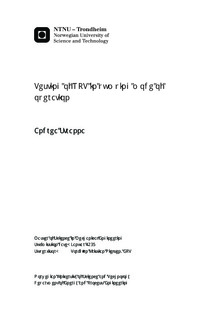Testing of RPT in pumping mode of operation
Master thesis
Permanent lenke
http://hdl.handle.net/11250/235034Utgivelsesdato
2013Metadata
Vis full innførselSamlinger
Sammendrag
In this project two pump mode tests has been carried out on a model RPT in the Waterpower Laboratory at NTNU. The measurement set up and execution of the tests were the same, except for the method of dissipating energy in the system. In the first test one of the feed pumps in the basement was used as energy dissipator. In the second test a throttle valve was used as energy dissipator. The objective has been to see how the Waterpower Laboratory is suited for such a test. It was also important to test the two different dissipation methods and evaluate which should be preferred when performing a pump mode test. During the tests it was observed that the guide vane angle kept changing. When the results were processed it became evident that the variations in guide vane angle during the tests had a big influence on the measured pump curves. Variations in guide vane angle has not previously been observed during turbine mode testing. It is presumed that the variation in guide vane angles is due to play in the guide vane system and the design of the guide vanes. The guide vanes are Francis vanes, and not RPT vanes. It is assumed that it is the sharp trailing edge of the guide vanes that causes turbulence over the vanes in pump mode, thus making the guide vanes move about within the play of the guide vane system. It is suggested that the guide vane system is replaced with an RPT guide vane system for further testing in pump mode. The two dissipation methods tested were both effective. The throttle valve works best for achieving 0 flow, while the feed pump is easier to regulate. None of the methods showed signs of high noise or vibrations, and both may be used for future tests.
